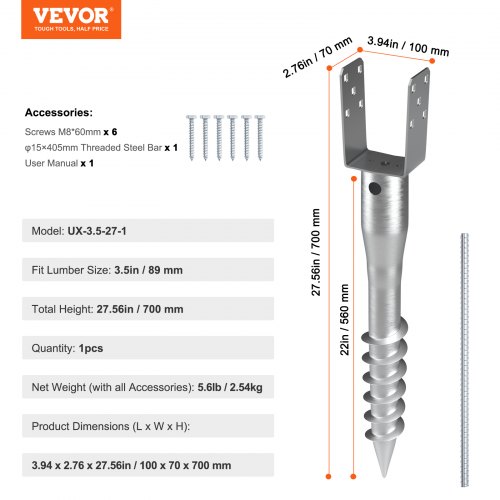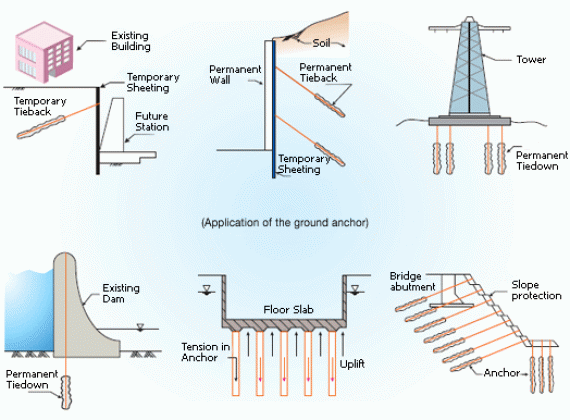How Heavy-Duty Earth Anchors Job: A Comprehensive Overview to Dirt Anchoring Solutions
Heavy-duty Earth supports play an essential role in giving stability and support in various building and construction applications. By embedding deeply into the ground, they resist lateral and upright pressures efficiently. Various sorts of supports deal with different dirt problems, making them functional. Recognizing their auto mechanics and setup techniques is vital for optimizing performance. What variables influence their efficiency, and just how do they compare to traditional methods? The responses may amaze you.
Understanding Sturdy Earth Anchors
Sturdy Earth anchors function as crucial parts in different building and landscaping projects, offering security and assistance in difficult soil conditions. These anchors operate by being installed right into the ground, where they withstand upright and side pressures. Their layout enables protected accessory to structures, guaranteeing they remain anchored against dirt motion or external loads.The efficiency of durable Earth anchors greatly depends on the sort of dirt and the support's installment deepness. Correct installation techniques are important, as they figure out the anchor's holding capacity. Environmental factors, such as dampness and freeze-thaw cycles, can likewise impact performance.These supports are regularly utilized in applications varying from protecting fences and keeping walls to stabilizing short-term structures during negative climate problems. Comprehending the concepts behind heavy-duty Earth supports is important for professionals looking for to enhance the durability and security of their projects.
Kinds of Heavy-Duty Earth Anchors
Different kinds of durable Earth anchors are made to fulfill certain demands based upon dirt problems and project demands. Helical anchors, featuring screw-like blades, are efficient in softer dirts, using high tons capacities and easy installment. Driven supports, which are hammered into the ground, appropriate for rocky surfaces and give instant tons support. Tie-back supports are generally used in keeping wall applications, enabling side assistance by anchoring into the ground at an angle. One more kind is the cast-in-place anchor, ideal for concrete applications, as they are integrated right into structures for improved security. Soil screw supports are versatile alternatives that can be used in different dirt kinds, offering trusted tension and compression abilities. Each kind offers unique applications, guaranteeing stability and safety in building and construction and landscaping tasks. Understanding these alternatives permits educated choices in picking the suitable Earth anchoring option.
The Mechanics of Dirt Anchoring

Recognizing the auto mechanics of dirt anchoring requires an assessment of numerous kinds of Earth supports and their installment strategies. Each support type offers distinct features that influence its efficiency in different soil conditions. Appropriate installment approaches are necessary for optimizing the securing system's security and efficiency.
Sorts Of Earth Anchors
Earth supports, necessary elements in dirt anchoring systems, can be found in numerous kinds, each created for particular applications and dirt conditions. The most typical types include screw supports, which are turned into the ground, giving solid side resistance. Helical anchors include blades that enable reliable installment in various dirt kinds, making them ideal for both permanent and short-lived applications. Driven supports, commonly made from steel, are inculcated the soil and work in rough or dense environments. Auger anchors make use of a helical style to help with installment in softer dirts. Plate supports consist of a level plate buried horizontally, distributing tons over a larger location, ideal for applications calling for high lots capabilities in cohesive dirts.
Installation Strategies Clarified
Proper installment techniques are essential for the efficiency of dirt anchoring systems. The process typically starts with website assessment, validating the selected area can sustain the anchor's lots. After determining the right anchor type, proper opening depth and angle have to be established. The installation includes driving the support into the ground utilizing customized devices, such as hands-on or hydraulic vehicle drivers, to accomplish best embedment. Post-installation, tensioning the support is important to assure security; this is frequently confirmed with lots testing. Furthermore, bordering soil conditions must be kept track of to avoid variation. Complying with these methods not only improves the support's efficiency but likewise prolongs its lifespan, providing dependable support for different applications.
Applications of Heavy-Duty Earth Anchors
While heavy-duty Earth supports are frequently connected with building and construction and landscape design, their versatility extends to a selection of applications throughout different industries. In civil engineering, they give essential assistance for retaining wall surfaces, making certain stability in areas prone to soil disintegration. The marine market makes use of these supports for safeguarding anchors and marinas, stopping motion brought on by tides and currents. Additionally, in the telecom market, heavy-duty Earth anchors are significant for maintaining cell towers and various other tall structures versus wind pressures. Agricultural applications additionally profit, as these supports can protect structures like greenhouses and livestock fencing, guaranteeing they hold up against rough weather problems. In addition, in eco-friendly energy jobs, such as wind farms, Earth anchors play an essential function in safeguarding generator structures, improving total security and performance. This wide series of applications highlights the flexibility and reliability of sturdy Earth supports across various areas.
Advantages Over Typical Anchoring Methods
Standard anchoring methods have actually long been relied upon for stability, sturdy Earth supports use significant benefits that improve efficiency and efficiency. One significant advantage is their remarkable load-bearing capacity, which enables them to stand up to better forces without failure. This stamina makes them perfect for requiring applications, such as in construction and energy installations.Additionally, durable Earth anchors are created for deeper setup, supplying better stability in numerous dirt problems, consisting of sandy or loose soils. Their resistance to deterioration and ecological elements guarantees a much longer life-span and reduced maintenance expenses contrasted to standard methods.Moreover, these supports can be mounted with minimal disruption to the surrounding area, preserving the integrity of the landscape. Generally, heavy-duty Earth anchors provide a reliable and reliable remedy for anchoring needs, exceeding the constraints often related to standard anchoring techniques.
Installation Process and Ideal Practices
The installment process for soil anchoring solutions begins with extensive preparation and site analysis to guarantee peak performance. Following this, a step-by-step installation guide offers clear instructions for effective implementation (heavy-duty earth anchors). Sticking to these finest practices is important for achieving reliable and long-lasting anchoring outcomes
Prep Work and Site Analysis
Efficient prep work and complete website analysis are essential action in the installation of dirt anchoring services. Before installation, the soil kind need to be evaluated to identify its bearing capacity and suitability for anchoring. Performing a geotechnical survey can provide vital details concerning soil make-up, moisture degrees, and potential ground motion. Additionally, recognizing existing structures, vegetation, and energies is vital to stay clear of interference during setup. The location must be removed of debris and challenges to guarantee risk-free accessibility for tools. Weather must also be kept track of, as adverse conditions can influence both security and installment efficacy. By diligently preparing the site and reviewing all relevant aspects, the possibility of effective anchor performance is significantly boosted.
Step-by-Step Installation Guide
A comprehensive setup procedure is crucial for attaining perfect performance of soil securing remedies. The setup begins with selecting the suitable anchor kind and guaranteeing the website is clear of particles. Next off, correct opening placement is figured out based upon lots requirements. As soon as the location is developed, holes are drilled to the specified deepness and diameter using the appropriate devices. The anchor is after that placed right into the hole, making certain it is aligned correctly. After securing the anchor, soil is backfilled and compacted to enhance security. It is vital to adhere to supplier standards throughout the procedure. A post-installation examination validates that the supports are sufficiently positioned and operating as intended, providing trusted assistance for the designated application.

Maintenance and Examination of Earth Anchors
Routine upkeep and assessment of Earth supports are necessary for making sure long-term Go Here performance and security. Routine checks allow for the early discovery of problems such as corrosion, loosening up, or soil movement. Assessors should seek indications of rust or destruction on the support components, especially at the link factors. In addition, the bordering dirt ought to be assessed for erosion or modifications in dampness web content, which can affect anchor effectiveness.It is suggested to develop a regular examination schedule, ideally at least once read review a year, relying on environmental conditions. During examinations, all noticeable components must be cleaned up to eliminate dirt or particles that could hide possible troubles. Any type of signs of distress, such as tilting structures or uncommon settling, need to motivate instant evaluation. Correct documentation of assessments can assist in monitoring support performance gradually and promote timely upkeep actions, guaranteeing the anchors stay trusted and useful.
Often Asked Concerns
What Materials Are Heavy-Duty Earth Anchors Generally Made From?
Sturdy Earth supports are usually built from long lasting products such as galvanized steel or stainless-steel, ensuring strength and resistance to rust. These products give resilient support and stability in numerous soil problems and applications.
Just How Do Soil Conditions Impact Support Performance?
Dirt problems significantly influence anchor efficiency. Factors such as soil kind, moisture content, and compaction impact the support's grip and stability, with natural soils usually supplying much better resistance than sandy or loosened soils, impacting total efficiency.
Can Heavy-Duty Earth Anchors Be Recycled After Removal?
Sturdy Earth supports can be reused after elimination, offered they are inspected for damages and wear. Appropriate cleansing and maintenance improve their long life, making certain effective performance in subsequent setups when problems enable risk-free reinstallation.
What Are the Ecological Influences of Using Earth Anchors?
The environmental influences of making use of Earth supports consist of possible dirt disturbance, disruption of local environments, and feasible contamination of groundwater. If made use of sensibly, their advantages usually exceed these worries, promoting security in different applications.
Exactly how Do I Select the Right Anchor for My Project?
